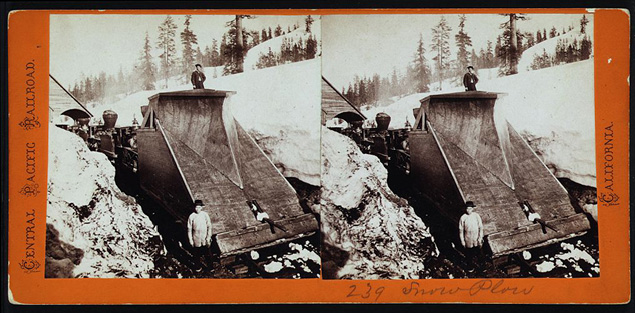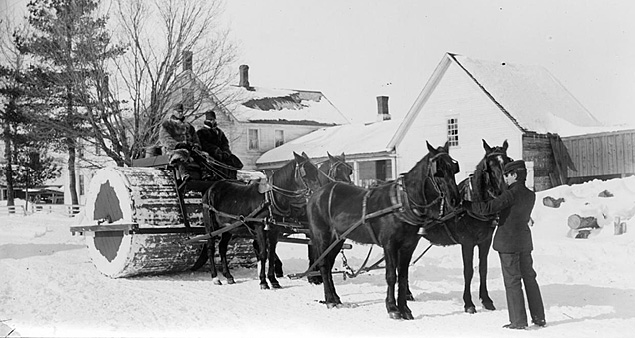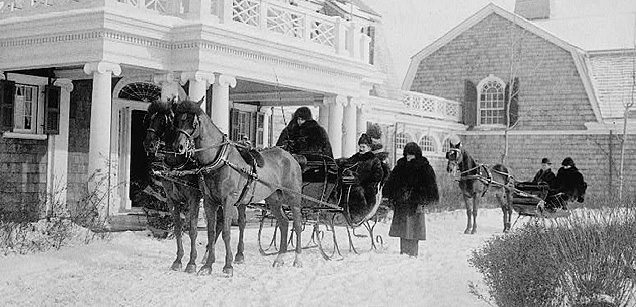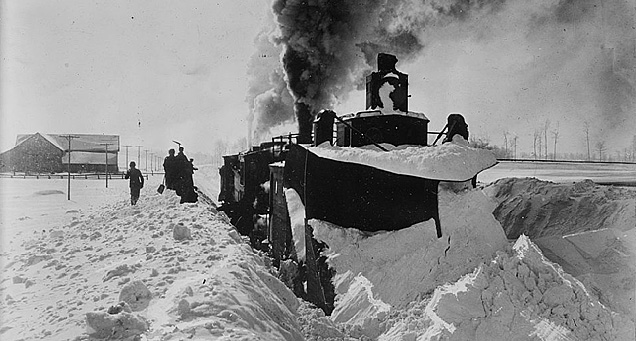How did they do it?
The Great Snowstorm of 2015 turned out to be a bust here in New Jersey — a fact for which The Legal Genealogist is exceedingly grateful. If we end up with 10-12″ of snow total, rather than the 24-30″ predicted, that will be a lot.
New England, on the other hand, is still being hammered. Snowfall totals already exceed two feet and the snow is still falling.
Road crews are out constantly trying to stay ahead of the snowfall, clearing the roads, salting, sanding.
Which of course raises the question…
What did our ancestors do about snows like this?
For the vast majority of rural folks, of course, winter was a time for hunkering down and hoping you didn’t use up all the supplies you’d laid in during the spring, summer and fall before the last snow fell and the ground started “greening up” again.
But what if you were in town? Or a city?
Just when did the snow plows start coming around anyway?
Start with the fact that the first patents on snow plows were granted in the 1840s,1 and most of them focused on clearing snow from railroad tracks, not from roads:

Alfred A. Hart, “Snow plow,” stereo card, California, c1865-1869.2
In fact, in many communities, what was done was rolling the snow flat to pack it down:

Tennie Toussaint, “Horses pulling a snow roller,” Danville, Vermont, c1900.3
That made it easier to use vehicles with runners — sleds and sleighs — on the roads:

“Horse-drawn sleighs with passengers in front of house,” c1904.4
The first reported use of a snow plow on a street was in 1862 in Milwaukee but the use of mechanized snow removal systems didn’t become widespread until the 20th century.5 And they sure didn’t look much like the ones out there today trying to dig out in New England:

Bain News Service, “Snow plow in field in Michigan,” likely early 20th century.6
Aren’t you glad you live now, and not then?
SOURCES
- See e.g. Samuel Streeter, “Car-Track Clearer,” Patent No. 5347 (1847); digital image, “US Patent Full-Page Images,” U.S. Patent and Trademark Office (http://patft.uspto.gov/netahtml/PTO/patimg.htm : accessed 26 Jan 2015). ↩
- Alfred A. Hart, “Snow plow,” stereo card, California, c1865-1869; Library of Congress Prints & Photographs Division (http://www.loc.gov/pictures/ : accessed 26 Jan 2015). ↩
- Tennie Toussaint, “Horses pulling a snow roller,” Danville, Vermont, c1900; digital image, University of Vermont Libraries Center for Digital Initiatives (http://cdi.uvm.edu/collections/index.xql : accessed 26 Jan 2015). ↩
- “Horse-drawn sleighs with passengers in front of house,” c1904; Library of Congress Prints & Photographs Division (http://www.loc.gov/pictures/ : accessed 26 Jan 2015). ↩
- See generally “Snow Removal,” National Snow and Ice Data Center (https://nsidc.org/ : accessed 26 Jan 2015). ↩
- Bain News Service, “Snow plow in field in Michigan,” likely early 20th century; Library of Congress Prints & Photographs Division (http://www.loc.gov/pictures/ : accessed 26 Jan 2015). ↩



Too young for the horse-drawn sleighs, but I do remember snow plows on the front of the engines moving along the railroad track a block from our house in Idaho as was growing up. They were a sight to behold!
I grew up a 90-second walk away from the main line of the Pennsylvania Railroad — and don’t remember the plows at all. Sigh… Must have been amazing to see.
I live near South Bend, Indiana and the Studebaker’s mansion supposedly has underground tunnels that the family used during the winter. The tunnels went to places like the Studebaker factory, the family’s church, and to other family member’s homes. This is what the tour guide told us but we weren’t allowed to actually SEE these tunnels, much to my dismay. But I have heard of such things in other cities as well. My university (in Michigan) has tunnels running under the campus that was supposedly once used for students to traverse in the winter as well. I don’t know how common or how true any of this is but it can make for fun ghost stories! 🙂
If I lived in Michigan, I’d want tunnels too!
Remember, though, Judy that those rural people hunkering down during the winter season still had livestock to take care of, and other reasons that they had to go outside. When I lived way up in the mountains in CO when I was a kid, we didn’t have indoor plumbing so we had to go outside for every drop of water, and whenever we needed to go to the bathroom—and the outhouse was a good distance from the house. There were a couple of horses and usually three of four cows which had to be cared for and fed, and the cows milked. My dad had to make sure that the snow didn’t cover the stovepipes on the roof, which would have caused considerable problems. We had to get out to the road to catch the bus to school. My parents had a rule that if the bus could get up the “hill” to our community, we had to get on it unless we were sick. So while people were hunkered down in those rural communities, there was still a lot of outdoor activity going on
Absolutely a lot of outdoor activity, Mary Ann — but planned-for and prepared-for! And not dependent on things like coal deliveries to the apartment building furnace.
I grew up in a western mountain valley that regularly got snowed in when the passes closed down. Not much snow in the valley, but when I look back on it, I kind of marvel out how well we did. Good for business, all those stranded travelers. We knew better than to try.
I live in Vermont now. Vermonters get glum when it doesn’t snow, so the mood anticipating the storm here has been pretty upbeat. However, in my Vermont village, the snow plows create more problems than they solve. What good does it do to plow the roads and streets if it results in huge mounds of compacted snow across the driveway and walks? That have to be moved again, usually by hand? Ugh. There are old-timers here who remember when the roads in some places were still rolled, and wish they still were. (As soon as the plows go through, the sirens start up.) One year we got a great storm that wouldn’t quit and the side roads didn’t get plowed for several days. People loved it: skiers and snowshoers on the streets. Kids on sleds. Happy villagers.
Where I lived in the Colorado Rockies, they still do oack the snow on all but the main roads. Of course, the situation is different there: the snow is dry and drivable, not wet and slippery like New England’s. The air is dry too, so what was left on the main roads subliminated off. Safe for the tourists. I loved living there: I could step out my door, put my snowshoes on, and take off anywhere. I tried that here once, following side streets and dirt tracks. On the way home had to take the snowshoes off- all those piles of dirty, compacted snow. Bah humbug. In Vermont I have to actually *drive* to a trail to snowshoe!
It sure is pretty out there right now, though. Main part of the storm hasn’t got here yet, and looks like it may slide right by. Darn.
I’m not a winter person, never have been and never will be, so the idea of looking forward to snow is alien to my mind processes.
Farm families often put a rope between the house and the barn in case of storms. People hung onto the rope when going back and forth. And, have read more than one account of children and adults being frozen after being caught in an unexpected storm. Just reading the “Little House on the Prairie” series by Laura Ingalls Wilder gives some an idea of what it was like. Can’t imagine it was easy. Our nephew said they have over 2 ft. in Boston right now and snow is coming down hard. Might be over 3 feet by the time the storm ends.
The worst I’ve read about was the blizzard called the Children’s Blizzard — 230+ lives lost in January 1888.
I have a photo of my grandfather captioned “L.B. Walker, county engineer; Percey Struck and Ernie Miller stand next to Franklin county’s new, $13,000 snow auger in 1929.”. Not a plow, it was like a big snowblower. Iowa snow is a PITA.
That is very cool. Lots of images of snow augers in the patents database.
When I was a kid, my mother taught me that “snow” was a “four-letter word” and was to be treated like all those other “four-letter words” that I was not allowed to say. I remember having to shovel snow before leaving for school, and snow drifts 3 feet high to climb over on the way.
Sounds like your mother — and you — are as “enthusiastic” about snow as I am…!
A friend of ours used to live in a historic farmhouse in Vermont which had a sort of enclosed breezeway running from the house to the barn so that the farmer would always be able to care for his animals, no matter how deep the snow. But my favorite solution of all is the elevated walkway up in Saint John, New Brunswick, which allows people to walk throughout the central business district without going outdoors — no winter cold, no summer heat, and NO TRAFFIC. Brilliant!